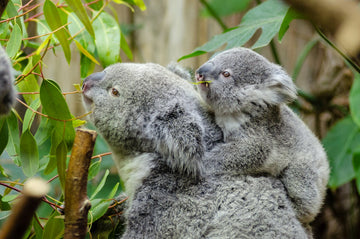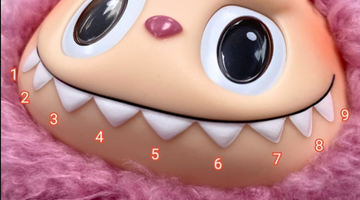Koalas are one of Australia’s most recognizable animals, often called "koala bears," though they are not true bears. These unique creatures have captured the interest of people around the world due to their distinctive appearance and behaviors.
This article highlights 12 fun facts that reveal interesting and lesser-known details about koalas. Understanding these facts helps clarify common misconceptions and provides a clearer picture of what makes koalas special.
1) Koalas are marsupials, not bears.
Koalas are often mistakenly called "koala bears," but they are not bears. They belong to a group of mammals called marsupials, which carry and nurse their young in pouches.
Marsupials include animals like kangaroos, wombats, and bandicoots. Koalas are more closely related to these animals than to any species of bear.
Unlike bears, koalas have specialized adaptations for climbing trees and feeding on eucalyptus leaves. Their diet and physical traits reflect their marsupial biology.
This distinction is important because it highlights how koalas evolved separately from bears, adapting uniquely to their environment in Australia. For more details on koalas as marsupials, see WWF Australia’s interesting koala facts.

2) Koalas have fingerprints similar to humans.
Koalas possess fingerprints that are remarkably similar to those of humans. The patterns on their fingertips include loops and whorls, just like human fingerprints. This similarity is so close that even experts find it difficult to tell them apart under a microscope.
This phenomenon is an example of convergent evolution, where unrelated species develop similar traits due to comparable environmental pressures. In koalas’ case, their fingerprints help with gripping tree branches and climbing.
The unique patterns are individual to each koala, much like human fingerprints. Forensic scientists have reported being misled in rare cases because koala prints can be nearly indistinguishable from human ones.
You can find more information about the near-identical nature of koala fingerprints at NOVA on PBS.
Bring on the charm with our dreamy Blue Dress collection. Ideal for picture days, parties, or just feeling fabulous.
3) They primarily eat eucalyptus leaves, which are toxic to most animals.
Koalas have a diet that consists almost entirely of eucalyptus leaves. These leaves contain oils and toxins that are harmful to most animals. Despite this, koalas can safely consume them due to their specialized digestive system.
Their stomachs have a unique ability to break down the fibrous and poisonous components of eucalyptus leaves. This adaptation allows koalas to extract the limited nutrients they need from such a low-energy diet.
Eucalyptus leaves also provide koalas with most of their water intake, as they contain about 50-55% water. This means koalas rarely need to drink from other sources.
Their slow metabolism helps conserve energy while digesting these tough leaves. Because of this, koalas spend much of their time resting and sleeping.
Learn more about their diet and digestion at the Australian Koala Foundation.

4) Koalas sleep up to 18-22 hours a day.
Koalas spend most of their day sleeping or resting, typically between 18 and 22 hours. This extended sleep helps them conserve energy. Their diet of eucalyptus leaves is low in nutrients and takes a long time to digest, which limits the energy they can extract.
Because eucalyptus leaves are fibrous and toxic, koalas must rest extensively to process their food safely. During the daylight hours, they are often found curled up or tucked into the forks of trees, where they remain mostly inactive.
Their slow metabolism supports this long rest period, allowing them to avoid using excessive energy. This behavior reduces their need for frequent feeding, which is crucial because eucalyptus leaves offer limited calories and nutrients.
For more details on koalas’ sleeping habits, you can visit this page about interesting facts about koalas.
5) They have one of the smallest brain-to-body ratios among mammals.
Koalas have a notably small brain compared to their body size. Their brains weigh about 19 grams, which is roughly 0.2% of their total body weight. This ratio is much lower than that of most other mammals.
Additionally, their brain fills only around 60% of their skull cavity, with the remaining space taken up by fluid. This is unusual since most mammals have brains that fill most of the cranial space. The smooth surface of their brain also sets them apart from species with more complex, folded brains.
Despite their small brain size, koalas have adapted well to their environment. Their brains support essential functions like climbing, feeding, and social behaviors, even if they are not considered highly intelligent. For more details, see the curious facts about koalas and information about their brain size and structure from Animal Club.
6) Koalas produce a strong eucalyptus scent.
Koalas, especially adult males, emit a strong eucalyptus-like odor. This scent comes from glands on their chest and is used to mark territory. The smell can be quite noticeable to other koalas nearby.
Young koalas and females also give off a milder eucalyptus scent. This natural odor helps in repelling insects, providing some protection against pests.
The scent plays a key role in communication within koala populations. It signals dominance for males and helps others identify individuals in the wild.
Koalas feed almost exclusively on eucalyptus leaves, which influences their unique smell. Their diet and scent are closely linked, as eucalyptus oils carry the distinctive aroma they produce.
For more details on how eucalyptus scent affects koalas, you can visit interesting facts about koalas from Tourism Australia. Dress her in timeless elegance with our Linen Girl Dress collection. Soft, breathable, and perfect for every season and occasion.
.
7) Their babies, called joeys, develop in the mother's pouch.
Koala babies are called joeys. When born, a joey is extremely small—about the size of a peanut—and underdeveloped. It measures roughly one gram at birth and cannot see or hear.
Despite this, a newborn joey instinctively climbs into its mother's pouch without any help. Inside the pouch, it attaches to a teat and continues developing safely for about six months.
During this time, the joey grows rapidly. It feeds on its mother’s milk, which is rich in nutrients. After leaving the pouch, it will ride on its mother’s back for several more months while learning to eat eucalyptus leaves.
The pouch is essential for the joey’s survival, providing warmth and protection as it matures. This unique reproductive behavior allows koalas to nurture fragile young in the wild.
More about the koala’s life cycle and joey development is available at the Australian Koala Foundation.

8) Koalas chew their food slowly to detoxify eucalyptus leaves.
Koalas have a very slow chewing process. This allows them to break down the tough eucalyptus leaves thoroughly.
Eucalyptus leaves contain toxins that are harmful to most animals. Koalas rely on special liver enzymes to detoxify these poisons.
Chewing slowly helps koalas release more nutrients and reduces the risk of poisoning. This process supports their unique diet despite the low nutrition level of the leaves.
Koalas also have symbiotic gut bacteria that assist digestion. These bacteria help break down toxic compounds and extract energy from the fibrous leaves.
On average, koalas eat between 200 to 500 grams of leaves daily. Their careful chewing and detoxification system enable them to survive on such a limited food source.
Koalas spend much of their time resting or sleeping, often 18 to 22 hours a day. This conserves energy since digesting eucalyptus is demanding and slow.
More details on how koalas digest eucalyptus can be found at the Australian Koala Foundation’s page on Koalas' Diet & Digestion.
Freshen up her wardrobe with our vibrant Green Dress Collection . From playful to elegant, there's a perfect green for every girl!
9) They rarely drink water, getting most moisture from leaves.
Koalas get nearly all their water from the eucalyptus leaves they eat. These leaves contain about 50-55% water, which usually meets their hydration needs.
Because of this, koalas rarely need to drink water. They can drink if necessary, such as during droughts or extreme heat, but generally avoid it.
Their name even reflects this trait. "Koala" comes from an Aboriginal word meaning "no water," highlighting their ability to thrive without drinking much.
This adaptation helps koalas survive in environments where water sources are scarce or unpredictable. It also reduces the time they spend on the ground looking for water.
By relying on moisture-rich leaves, koalas conserve energy and avoid predators. This water strategy is a key part of their unique lifestyle in the Australian bush.
More details about this distinctive feature can be found at WWF-UK’s facts about koalas.
10) Koalas can become aggressive if threatened, using sharp claws and teeth.
Koalas are generally calm animals, but they can become aggressive when they feel threatened. They use sharp claws and strong teeth to defend themselves in such situations. These defenses can cause injury if a koala lashes out.
Their claws are long and curved, designed for climbing trees, but also effective for scratching. When cornered or stressed, koalas can bite or latch onto an attacker. Despite their somewhat slow movements on the ground, their defensive behavior can be quite forceful.
Aggression is often a response to stress or fear rather than inherent hostility. While incidents involving humans are rare, caution is advised when encountering wild koalas. Learning to respect their space helps avoid triggering defensive behavior.
For more details on koalas’ aggressive traits, see koalas’ sharp claws and teeth and their behavior when threatened.
Show your state pride in style with our bold and spirited Alabama Elephant collection. Perfect for game days, tailgates, and southern charm!
11) Each koala has a unique vocalization for communication.
Koalas use a variety of sounds to communicate with each other. Males produce deep bellowing or grunting calls that can carry for several kilometers, especially around sunrise and sunset. These vocalizations help establish territory and attract mates.
Female koalas, while generally quieter, also make noises like squeaks, grunts, and even screams. These sounds are often used to communicate with their young or signal distress. The diversity in their vocalizations shows a complex form of social interaction.
Each koala’s call has subtle differences, making their vocalizations somewhat unique. This enables individual recognition among koalas within overlapping habitats. Their use of multiple sounds highlights their adaptation to forest environments where visual contact is limited.
The ability to produce distinct vocal patterns plays a key role in koala behavior and survival. For more detailed information, see the research on koala communication and vocalizations.

12) Koalas have a specialized digestive system to break down toxic leaves.
Koalas feed almost exclusively on eucalyptus leaves, which contain toxic oils and compounds. These chemicals would be harmful or fatal to most animals.
To handle this, koalas have evolved a specialized digestive system. Their caecum, a part of the gut, ferments the fibrous leaves and helps detoxify the poisons.
They also have special liver enzymes and symbiotic gut bacteria that break down the toxic compounds. This adaptation allows them to extract essential nutrients from an otherwise harmful diet.
The digestion process is slow and energy-intensive. Koalas spend much of their time resting to conserve energy while their system processes the leaves.
This unique digestive ability supports their survival in habitats where few other animals can feed. More details on their digestion can be found at the Australian Koala Foundation and WWF.
Style That Speaks to Every Moment
Whether you're dressing your little one for a game day celebration, a sunny outing, or a special occasion, choosing the right outfit makes all the difference. From the bold spirit of our Alabama Elephant collection to the classic charm of the Linen Girl Dress , there’s something for every personality and moment.
Add a pop of timeless color with pieces from our Blue Dress collection, or embrace playful elegance with the fresh styles in our Green Dress Collection . No matter the occasion, Sandi Lake Clothing has your little one's look covered from head to hem.





